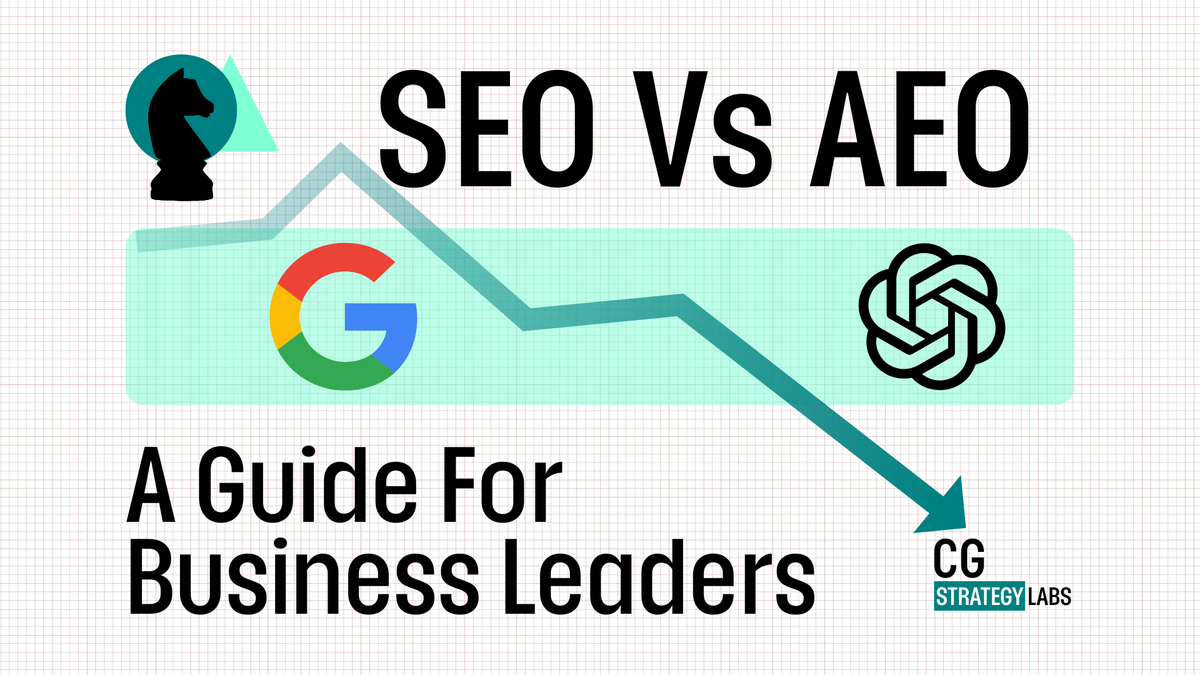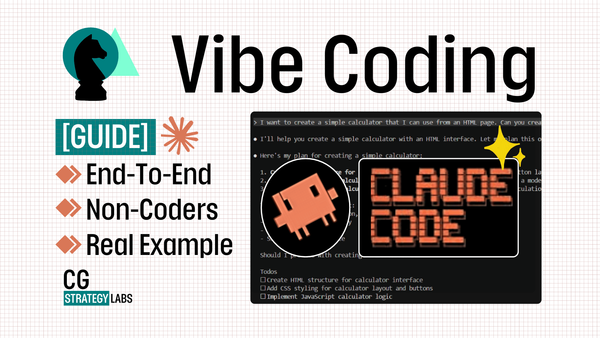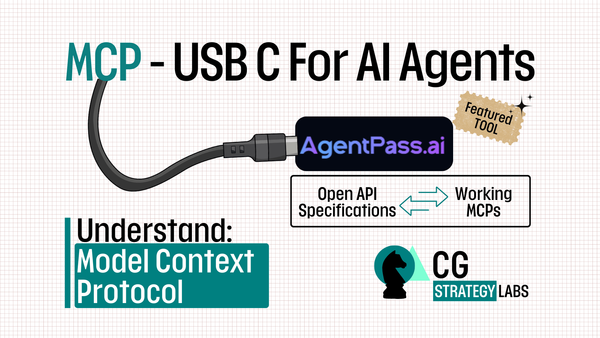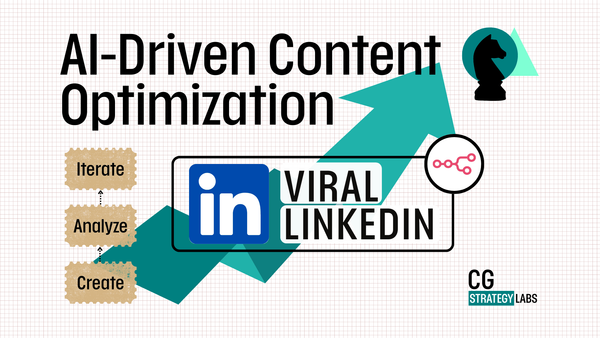AEO vs SEO: What Business Leaders Actually Need to Know

The Strategic Guide to Understanding Answer Engine Optimization (vs SEO)
Everyone's Talking About AEO, But Nobody Agrees What It Actually Means.
Ask 10 marketing experts to explain AEO and you'll get 11 different answers. Some say it's just "SEO for AI." Others claim it's a completely different discipline.
Most throw around technical terms that will leave you more confused than where you started.
This guide cuts through the confusion with clear, practical insights that help you make informed strategic decisions about the future of search.
What You'll Learn in This Guide:
- ✅ The Difference: What SEO and AEO mean for your business (no jargon)
- ✅ Strategic Impact: How each affects your brand authority & positioning
- ✅ Market Timing: Why smart businesses are investing in AEO now
- ✅ Practical Framework: 4-pillar assessment to determine your AEO readiness
- ✅ Implementation Clarity: When to prioritize SEO vs AEO vs both
A fundamental shift in how people find information is creating new opportunities for businesses that understand it early.
Smart businesses are building authority in AI-powered search results.
They're getting cited as experts when prospects ask ChatGPT, Perplexity, or Google's AI for recommendations.

What SEO Actually Is (Beyond the Buzzwords)
Let's start with what you already know - or think you know.
Search Engine Optimization (SEO) is the practice of creating and structuring content so search engines like Google show your website when people search for topics related to your business.
The basic mechanism works like this:
- You create content targeting specific keywords
- Search engines index and rank your content
- People search for those keywords
- Your website appears in search results
- People click through and visit your site
The Business Purpose of SEO
Companies invest in SEO because it creates a predictable channel for attracting potential customers who are actively looking for solutions you provide.
Key business outcomes include:
- Organic traffic: Visitors who find you through search (no paid ads required)
- Quality leads: People searching for your solutions are often ready to buy
- Brand visibility: Higher rankings build awareness in your market
- Long-term asset: Good content continues attracting visitors for years
How Success is Measured
Traditional SEO success looks like this:
- Keyword rankings: Your content appears on page 1 for target search terms
- Website traffic: More people visit your site from search engines
- Conversion rates: Visitors take desired actions (sign up, buy, contact you)
- Brand searches: People start searching for your company name directly
Timeline and Investments
SEO typically requires 3-6 months to show meaningful results, with significant impact often taking 6-12 months. It's a long-term strategy that compounds over time - think of it as building a digital asset rather than running a campaign.
The beauty of traditional SEO is its clarity: you optimize content, it ranks higher, more people find you, and some percentage become customers. It's a direct path from optimization to business results.
Enter AEO - The Game Changer
Now here's where things get interesting - and where most explanations get confusing.

What AEO Actually Is
Answer Engine Optimization (AEO) is the practice of structuring your content so that AI-powered search tools cite you as a source when answering user questions.
Instead of trying to get people to click through to your website, AEO focuses on getting your expertise included in the AI-generated answers that people see first.
How AEO Actually Works
Here's the new mechanism that's emerging:
- You create authoritative content that definitively answers specific questions
- AI search tools (ChatGPT, Perplexity, Google AI, etc.) crawl and analyze your content
- When someone asks a related question, the AI includes your insights in its response
- Your business gets mentioned as a credible source - 'even if the person never visits your website'
A Real Example That Makes It Clear
Traditional SEO scenario:
- User searches "best project management software"
- Google shows 10 website links
- User clicks your link, reads your comparison article
- User evaluates your recommendations
AEO scenario:
- User asks ChatGPT "What's the best project management software for remote teams?"
- ChatGPT responds: "According to [Your Company's] analysis of remote team tools, the top options are..."
- Your expertise gets cited directly in the answer
- User sees you as the authoritative source without visiting your site
The Strategic Shift
This creates a fundamentally different dynamic. Instead of competing for clicks, you're competing to become the definitive source that AI tools reference.
The key difference:
- SEO = Get found when people search
- AEO = Get cited when AI answers
Your goal shifts from "ranking high in search results" to "being recognized as the expert that AI should quote."

Why This Matters for Your Business Right Now
Understanding why AEO matters now - not in five years - is crucial for strategic planning.
The Growth of AI Search
The numbers tell a clear story:
- ChatGPT has over 400 million weekly active users
- Google AI Overviews now appear in 47% of searches
- Perplexity processes nearly 1 billion queries monthly
- Voice assistants increasingly pull answers from AI engines
More importantly, user behavior is shifting. People are increasingly asking AI tools for recommendations, analysis, and advice rather than clicking through multiple websites to research on their own.
The Authority Amplification Effect
Here's what makes AEO powerful: when AI cites you as a source, it amplifies your authority exponentially.
Traditional marketing: You tell people you're an expert
Content marketing: You demonstrate expertise through valuable content
AEO impact: AI tells people you're the expert to trust
This third-party validation from AI tools carries significant weight because users perceive AI as objective and comprehensive in its source selection.
The Early Mover Advantage
Most businesses are still focused entirely on traditional SEO. This creates a significant opportunity for companies that understand AEO early.
Current market reality:
- High-quality, authoritative content in most industries is still limited
- AI tools are actively looking for credible sources to cite
- Competition for "AI attention" is much lower than competition for search rankings
- Building authority now positions you as the go-to source as AI search grows
What This Means for Competitive Positioning
Companies that establish AEO authority early will benefit from a compounding advantage. As AI tools learn to recognize certain businesses as definitive sources in their industries, those businesses will be cited more frequently across related topics.
Think of it as building a reputation with AI systems the same way you might build relationships with industry journalists - except the AI has access to a much larger audience.
Traffic Patterns
SEO Traffic:
- People click from search results to your website
- You control the full experience once they arrive
- Clear attribution—you know where visitors came from
- Conversion happens on your site with your messaging
AEO Authority:
- People see your expertise without visiting your site
- AI presents your insights in its own interface
- Brand awareness and credibility building
- Conversion may happen later through brand recognition
Brand Authority Building
SEO Authority:
- You rank well for industry keywords
- People find you when actively searching
- Authority is measured by search rankings and traffic
AEO Authority:
- You become the source AI tools reference
- People encounter your expertise even when not searching for you specifically
- Authority is measured by citation frequency and context quality
Customer Journey Impact
Traditional SEO Journey:
- Prospect has a problem
- Searches for solutions
- Finds your content in search results
- Visits your site to learn more
- Evaluates your credibility and offerings
- Makes decision
AEO-Influenced Journey:
- Prospect asks AI for advice
- AI cites your expertise in its response
- Prospect sees you as credible source immediately
- May visit your site with higher trust level
- Decision influenced by perceived AI endorsement
Competitive Dynamics
SEO Competition:
- Winner-take-most: Top 3 results get majority of clicks
- Direct competition for keyword rankings
- Success measured by outranking competitors
AEO Opportunity:
- Multiple sources can be cited in one answer
- Competition is for expertise recognition, not ranking position
- Success measured by citation quality and frequency
The strategic insight here is that SEO and AEO can work synergistically. Strong SEO content can become the foundation for AEO authority, while AEO citations can drive brand searches that improve SEO performance.

Understanding GEO - The Third Player
You'll also hear about "GEO" in these conversations, so let's clear up what that means and how it fits.
What GEO Actually Is
Generative Engine Optimization (GEO) is optimizing your content specifically for AI tools that generate new content, like ChatGPT creating articles, Claude writing analysis, or Google AI composing responses.
How GEO Relates to AEO
Think of them as cousins:
- AEO focuses on getting cited in AI answers to questions
- GEO focuses on influencing AI-generated content more broadly
Practical example:
- AEO: When someone asks "What's the best marketing strategy?" AI cites your framework
- GEO: When AI writes a marketing plan, it incorporates principles from your methodology
Why You Need to Know Both Terms
Different tools and contexts use different terminology, but they're addressing the same fundamental shift: optimizing for AI-powered information systems rather than just traditional search engines.
In practice:
- Most "AEO" strategies also improve "GEO" performance
- The content characteristics that work for one typically work for both
- The strategic business thinking is identical
For strategic planning purposes, you can think of AEO and GEO as part of the same broader opportunity: positioning your expertise to be recognized and utilized by AI systems.

Common Misconceptions (And Why They're Strategically Dangerous)
Let's address the confusion that could lead to poor business decisions.




Misconception 1: "AEO Will Replace SEO"
Why it's wrong: AI tools still get much of their information from websites that rank well in traditional search. Strong SEO often correlates with strong AEO performance.
Strategic reality: The businesses winning at AEO typically also have solid SEO foundations. They complement rather than compete with each other.
Misconception 2: "AI Search Isn't Generating Real Traffic Yet"
Why it's misleading: This focuses on the wrong metric. AEO's primary value is authority building and brand positioning, not immediate traffic.
Strategic reality: Companies like NerdWallet have seen revenue growth despite decreased direct traffic because AEO builds authority that influences purchasing decisions across multiple channels.
Misconception 3: "AEO is Too Technical for Our Team"
Why it's limiting: AEO success depends more on content strategy and subject matter expertise than technical implementation.
Strategic reality: The most important AEO factors are creating definitive, well-structured content that demonstrates clear expertise—things your team likely already does.
Misconception 4: "It's Too Early to Invest in AEO"
Why it's costly: This misunderstands how authority building works. Early investment in AEO creates compounding advantages.
Strategic reality: The businesses that establish AEO authority now will be harder to displace as AI search grows, similar to how early SEO advantages compounded over time.
The overarching strategic principle: AEO represents an opportunity to build authority while competition is still relatively low. The businesses that understand this now will be better positioned as AI-powered search continues growing.

What This Means for Different Business Functions
Here's how to think about AEO implications across your organization.
For Content Teams
Traditional focus: Create content that ranks well and drives traffic AEO addition: Structure content to be definitively authoritative on specific topics
Practical changes:
- Answer questions completely rather than teasing solutions to drive clicks
- Use clear headings and structured formats that AI can easily parse
- Cite data and provide specific examples rather than general advice
- Focus on demonstrating expertise rather than just keyword optimization
For Product Teams
Traditional focus: SEO for product pages and feature descriptions AEO opportunity: Position products as solutions AI recommends
Strategic approach:
- Ensure product information is comprehensive and easily accessible
- Create content that explains not just what your product does, but when and why to use it
- Develop comparison content that positions your solution objectively
- Build thought leadership around the problems your product solves
For Marketing Teams
Traditional campaigns: Drive traffic and conversions through owned channels AEO integration: Build campaigns that establish expertise AI systems recognize
Implementation:
- Develop content series that comprehensively cover industry topics
- Create resources that other businesses want to reference and cite
- Build thought leadership that positions executives as industry experts
- Measure authority signals alongside traditional traffic metrics
For Business Leadership
Strategic consideration: Understand how authority building through AI systems fits into competitive strategy
Key decisions:
- Investment allocation between traditional SEO and emerging AEO opportunities
- Content strategy that balances immediate conversion goals with long-term authority building
- Team development to build capabilities in structured, authoritative content creation
- Timeline expectations for authority building vs. direct response marketing
The common thread across all functions: AEO rewards depth of expertise and comprehensive coverage of topics rather than just keyword optimization tactics.

Your Strategic Path Forward
Start With Strategic Assessment
Before jumping into tactics, evaluate your business context. Understanding where you stand across audience intent, content authority, competitive landscape, and resource readiness will guide your strategic decisions.
Immediate Actions (Next 7 Days)
- Audit current position: What questions does your audience ask AI about your industry?
- Content inventory: Which existing pieces could be restructured for AEO?
- Competitive scan: Who's being cited as authorities in your space?
Strategic Planning (Next 30 Days)
- Resource allocation: Balance between SEO continuation and AEO investment
- Content calendar: Plan question-focused, authoritative content
- Team alignment: Ensure everyone understands the strategic shift
The Strategic Bottom Line
AEO isn't about replacing your current strategy—it's about extending your expertise into AI-powered information systems while competition is still manageable.
Key takeaways for business leaders:
- AEO and SEO work synergistically, not competitively
- Early authority building creates compounding advantages
- Business context determines how aggressively to pursue AEO
- Strategy and expertise matter more than technical optimization
The businesses that understand this shift now will be better positioned as AI-powered search continues growing.
CG Strategy Lab explores practical AI implementation insights that bridge strategy and execution. Share your comments here and connect with me on LinkedIn if you'd like to discuss this topic further.



![Practical Guide to Learning AI: From Tokens to Agents [ebook]](/content/images/size/w600/2025/08/Blog-Featured-Images...--4-.png)

